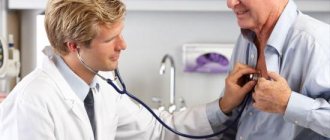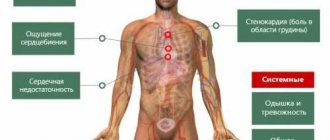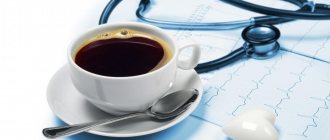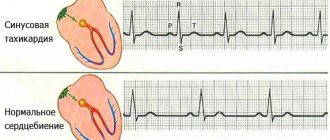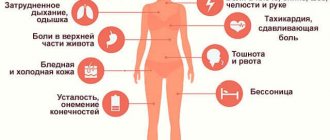Why does it occur
This disorder can occur under the influence of many factors. It's connected with:
- features of the development of the nervous system. Usually with asthenic type;
- vegetative-vascular dystonia;
- high blood pressure;
- hormonal changes in the body;
- poor environmental situation;
- working in hazardous industries;
- chronic infectious diseases.
But the main factors causing cardioneurosis are considered to be mental trauma and high blood pressure.
How to distinguish tachycardia?
Tachycardia occurs under the influence of external (exogenous) and internal (endogenous) factors.
When influenced by endogenous factors, tachycardia can be a consequence of diseases such as:
- heart defects;
- pathologies of the heart muscle (congenital and acquired);
- dangerous pathologies of the endocrine system;
- excessive bleeding due to injury;
- pulse instability;
- dehydration due to prolonged, continuous vomiting or diarrhea;
- high (febrile) body temperature;
- neuroses and neurosis-like conditions.
As can be seen from the list of causes of VSD, it is not included. The fact is that the diagnosis of VSD itself is not included in the international classification of diseases (ICD 10); it is replaced by a more expanded diagnosis: somatoform dysfunction of the autonomic nervous system. In the post-Soviet space, doctors continue to call the disease vegetative-vascular dystonia (VSD). In Europe, VSD is considered to be a type of neurosis-like condition.
From the list of causes of tachycardia it follows that the disease can occur due to various somatic pathologies. Therefore, if a patient experiencing frequent attacks of tachycardia does not have the developmental anomalies or pathologies listed above, we can assume the somatoform nature of the change in heart rate (tachycardia due to VSD).
Attention! The severity of tachycardia during VSD is determined by the type of heartbeat disorder.
In medicine, it is customary to distinguish the following types of tachycardia with VSD:
- Physiological tachycardia (occurs with excitement, falling in love, physical activity, passes gradually and unnoticeably);
- Pathological (due to the factors listed above).
Symptoms of tachycardia in neurosis
Deviation is accompanied by external and internal manifestations. Signs of pathology occur when a person experiences conflict, stress, or expects bad or good news.
Painful sensations in the heart can last for several days or even a month. They have varying degrees of severity:
- With cardialgia, a person is bothered by dull, pressing or sharp pain in the chest area. They can spread to other parts of the body, for example, the arm, shoulder blade, neck. These manifestations are accompanied by anxiety and fear of death. If you undergo an electrocardiogram, you may not notice any symptoms. But sometimes neurogenic cardialgia leads to spasm of the coronary arteries, which can cause circulatory problems.
- Panic attacks are observed, during which strong impulses of fear roll in, and hot and cold flashes disturb. There is a feeling of hiding and running away. The heart rate increases to critical levels.
- An increase in heart rate always accompanies panic attacks. It can also occur for other reasons: during severe physical exertion or as a result of early awakening. Tachycardia can become permanent.
- Patients report a feeling of heart sinking. This is how extrasystoles appear that occur in the morning. The heart may freeze for seconds, and after that the heartbeat returns to normal. If you change the situation or calm down, the symptom disappears.
- A feeling of shortness of breath, fever or chills indicate an incorrect reaction of the body to neurosis.
People suffering from neuroses are often diagnosed with vegetative-vascular dystonia, which occurs when the functions of the nervous system are impaired. Manifestations of rapid heartbeat can also be noticed after eating food. This is due to the rush of blood to the gastrointestinal tract.
These conditions also include a feeling of dizziness, trembling, swelling or paleness of the skin.
In hypertension, the presence of cardiac neurosis is accompanied by increased blood pressure, pain in the heart and headaches.
In such situations, treatment difficulties arise, since each patient complains of a large number of different symptoms.
It is important to be able to distinguish heart pain associated with neurosis from angina pectoris. If there are problems with the main muscle, any physical activity causes attacks of pain. You can improve your well-being only with the help of Nitroglycerin.
With neurosis, heart medications do not bring relief, so patients usually ask the doctor to prescribe something more effective.
Types of pathologies
Sinus tachycardia with VSD is the most common form of deviation characteristic of patients with VSD (especially in adolescence). Causes palpitations at night. The pulse can reach up to 90 beats per minute.
Paroxysmal tachycardia with VSD (paroxysmal) can begin in any part of the heart, therefore it can be supraventricular (atrial, atrioventricular) and ventricular; in patients with VSD, this type of tachycardia is much less common.
Paroxysmal tachycardia is caused mainly by more serious pathologies in the body than vegetative-vascular dystonia; VSD itself is characterized by sinus tachycardia.
Sinus tachycardia with VSD
In addition to the patient’s descriptions of his condition, the type of tachycardia during VSD can be determined using an electrocardiogram. The ECG result will show an almost unchanged pattern of waves, but the intervals (RR) between heart rhythms will be noticeably shorter, and sometimes the end of the previous and the beginning of a new cycle will even overlap each other. The electrical systole line will also be shorter with tachycardia at the time of VSD. The ST segment falls below the isoline.
Important! In itself, sinus tachycardia with VSD does not pose a threat to human life, but with frequent attacks of tachycardia or with a constantly accelerated rhythm, the heart wears out faster without rest, oxygen starvation of the heart muscle occurs, and coronary circulation is disrupted.
An attack of tachycardia during VSD is accompanied by an increase in blood pressure, an increase in heart rate to critical levels (from 150 to 250 beats per minute), shortness of breath, dizziness, a feeling of tightness and pain in the chest, fear of approaching death, and a panic attack begins. The duration of an attack of tachycardia during VSD depends on the general condition of the patient. It can last from several minutes to several hours and even days.
How to help during a seizure
Nervous tachycardia can cause serious disturbances in the functioning of the heart. Therefore, in case of prolonged attacks, it is necessary to take measures.
The following measures are used as first aid:
- The patient needs to be provided with fresh air. Therefore, you need to open a window indoors or take it outside.
- Put a person to bed.
- They calm and distract the patient from problems.
- They give sedatives in the form of Valerian, Validol or Corvalol.
- If you have a tonometer, measure your blood pressure and pulse.
First aid should be provided without noise and fuss. The patient's condition should be monitored by a doctor. Therefore, if there is a noticeable increase in the pulse and the appearance of weakness, it is necessary to call an ambulance or send the person to a medical facility in other ways.
The use of sedatives is indicated throughout the day from the onset of the attack. The breaks between taking medications should be several hours. When the symptoms disappear, the person is recommended to undergo testing.
Treatment of tachycardia due to nervousness
Tachycardia due to nerves is treated depending on the cause. If the provoking factors are not eliminated, the problem will persist for a long time.
Before prescribing medications, in order to improve your health, it is necessary to undergo an examination and reduce the negative impact of provoking factors.
During treatment, certain difficulties may arise. This is due to the fact that many patients with this diagnosis refuse to visit psychotherapists and do not want to follow the doctor’s recommendations, considering their disorder as something shameful.
Therefore, it is important to explain to the patient what his problem means and persuade him to visit other highly specialized specialists. For some patients, recovery occurs immediately after visiting a doctor and having a detailed conversation.
It is impossible to determine exactly which drugs to prescribe. The course of treatment depends on the symptoms and general condition of the body. First of all, tachycardia in depression and neurosis is eliminated by methods of getting rid of anxiety and psychological discomfort:
- A calming, encouraging and reassuring conversation is held with the patient. The patient should talk to the psychotherapist, who deals with such problems.
- They recommend streamlining your routine, getting more rest and eating right, avoiding stress and normalizing relationships in the family and at work.
- If the patient complains of feeling unwell, he is first prescribed mild sedatives based on medicinal plants and the cause of the disorder is eliminated.
There are neurological clinics that treat people with similar problems. Typically, such establishments house patients suffering from panic attacks, migraines and other nervous disorders.
In case of frequent attacks of neurosis, they can be stopped with the help of:
- light antidepressants in the form of Amitriptyline, Grandaxin, Azafen;
- beta blockers. If you are worried about tachycardia against the background of hypertension, then your well-being is improved with the help of Anaprilin and Trazicor;
- mild sleeping pills if a person suffers from insomnia. But he should use them no longer than a few weeks, since they quickly get used to them and cannot sleep without them;
- physiotherapeutic procedures. The condition is improved by using electrophoresis, pine and pearl baths, and electrosleep. Increased excitability can be eliminated with a Charcot shower and a circular shower;
- autogenic training and mental relaxation.
Classification
Tachycardia is an increase in the number of heart contractions. Depending on the reasons that caused such changes, it happens:
- extracardiac (the factor that provokes an increase in heart rate is localized outside the main “pump” in the human body);
- intracardial (the appearance of a symptom is associated with changes in the functioning of the heart).
Typical causes of VSD and tachycardia: intoxication (food, household), stress, increased physical activity. Exacerbation of chronic diseases, trauma and emotions can also cause tachycardia.
Depending on the source of impulse occurrence, the following types of heart rate increases are distinguished:
- Ectopic . The signal to contract occurs in the atrium, ventricle, or other part of the heart.
- Sinus . This is a physiological change in the functioning of the organ, which is accompanied by the formation of impulses in the corresponding node. With dystonia, this option is more common.
There is another conditional classification, according to the course: unexpected attacks of tachycardia (paroxysms) and a persistent form (constant).
Each of them has developmental characteristics.
Most often, tachycardia in patients with dystonia is extracardiac. Its reason is hidden in the disruption of the autonomic nervous system. But under no circumstances should you ignore the symptom. It can be a harbinger or manifestation of serious organic lesions of the cardiovascular system (coronary heart disease).
In any case, you should consult a doctor, especially if this symptom appears for the first time.
Symptoms
- Sinus tachycardia often feels like a palpitation. But the feeling that the heart is beating too fast can be accompanied by other unpleasant symptoms. For example, psychogenic extrasystoles or chest pain, which frighten an anxious person even more and convince him that he is seriously ill. A real heart attack is about to happen.
- The feeling of palpitations can occur only against the background of obvious nervous tension, and then disappear completely. Or he can accompany you almost constantly. An anxious neurotic person may feel as if their heart is beating faster even in their sleep – all night long.
- The true heart rate can be quite high - 140 and above. Or it may not exceed 90 beats per minute. Some riders complain of tachycardia even when their pulse is 68-72 beats per minute.
- The severity of sensations can vary significantly from day to day, from month to month. Moreover, changes can occur not only against the background of some obvious stressful events, but also simply “out of the blue.” It was really bad in May. And in June it’s better. In July, my “heart broke” again.
- The cardiogram usually shows normal sinus tachycardia. But at the peak of panic, episodes of ventricular tachycardia, bundle branch block and other changes can be observed, which again wildly frighten suspicious people, although they do not indicate any serious health risks.
- Feeling your heart pounding may actually be the only physical symptom of anxiety. But much more often it complements other bodily manifestations of anxiety - a feeling of shortness of breath, nausea, abdominal pain, etc. and so on.
Causes
The body's normal reaction to life
Tachycardia with neurosis, VSD, panic disorder occurs at the same time as in all other people on the globe. Another thing is that an anxious neurotic, concentrated on the work of his body in general and the heart in particular, interprets these normal physiological reactions as symptoms of an impending serious illness and even death.
The following can provoke an increase in heart rate both in neurosis and in good health:
- insomnia;
- alcohol consumption;
- caffeine;
- increased body temperature (both in the heat and during acute respiratory infections);
- changes in hormonal levels (primarily in women);
- a drop in blood sugar during hunger (the hunger itself may go unnoticed);
- smoking, etc.
And, of course, the heart rate always increases during physical activity. This is the norm. But suspicious, anxious people sometimes become so afraid of this norm that they notice a terrible heartbeat even when getting out of bed and walking across the room.
In fact, when rising from a horizontal to a vertical position, all people's heart rate increases. But not everyone thinks to count it.
Also, all people normally have an increase in heart rate after eating. But only anxious patients with VSD notice some kind of special tachycardia after eating, which often provokes the development of panic after eating.
Preparing for fight and flight
If you have generalized anxiety or panic disorder, or you believe that you suffer from vegetative-vascular dystonia, you are constantly worried. Even when you don't notice it. That is, your body is constantly preparing to run or fight. And it certainly increases your heart rate. That's how it should be.
In this case, palpitations are associated with an increase in the level of stress hormones, and with increased breathing, often leading to hyperventilation, and with the redistribution of blood in the body, and with the transition of muscles into a painful state.
All these reactions of preparation for active actions should increase the heart rate. And they do. And this indicates health, not illness.
Obsession with counting pulse
It has already been said above that patients with neurosis, VSD, etc. may notice tachycardia not only when it is present, but also in its absence. The heart rate will be a maximum of 90 beats, or even 72, the heart will beat perfectly evenly, but the neurotic will constantly complain about the palpitations and be sure that he is dying.
What can we say about the horror that covers a suspicious person at the moment when his heart actually beats at a frequency of 140 or more beats per minute. Patients with panic disorder interpret this behavior of their heart as the inevitable approach of death.
All the people in the store in line, especially if it's hot and stuffy, will get their heart rates racing. But only an anxious neurotic interprets this increase as dangerous. He is afraid of this danger. And with its fear it accelerates the heart even more. And he is even more afraid of this.
How can you tell if your heart is hurting?
Heart pain due to various pathologies of the nervous system is a common phenomenon. As we have already found out, the main cause of unpleasant sensations is the reaction to emotions. If there are any abnormalities in the functioning of the cardiovascular system, the main muscle of the body begins to ache. Doctors consider the main signs of “nervous” tachycardia to be:
- Dull or sharp pain in the chest. They can radiate to the neck, shoulder blade and other limb. Some people experience suffocation and fear of death. A nervous reaction to an increase in heart rate leads to a worsening of the condition. If you feel pain in your heart, calm down. In less than 10% of patients, this disease can cause complications in the form of a vascular reaction. It represents an extensive spasm of the veins and arteries. It can lead to disruption of the blood circulation of the heart, but the patients will not have ischemic disease.
- Extrasystole. Observed at certain intervals. It goes away on its own.
- Shortness of breath and chills. These manifestations indicate that there has been a strong release of adrenaline.
- Dizziness and changes in skin color. They indicate that the patient has problems with the autonomic system.
- A sharp increase in blood pressure.
Considering that the clinical manifestations of the disease are different, doctors are rarely able to immediately make the correct diagnosis. If tachycardia is present, the patient must undergo an examination to identify the causes of heart pain. Even if there are no visible signs of the disease, chronic hypertension or high levels of fat may indicate that the walls of blood vessels have begun to lose their elasticity. As a result of stress, blood through them will not be able to quickly reach the heart.
How to get rid of it?
- First of all, you need to undergo a medical examination. And make sure that everything is fine with your heart and other organs, for example, the thyroid gland. And your heartbeat actually occurs due to nervousness.
- Once you are convinced that your heartbeat is psychogenic in nature, seek help from a professional psychologist or psychotherapist who works with anxious patients. And start treating your neurosis.
Quick help measures
True recovery from an anxiety disorder is a complex, usually costly, and lengthy process. It can take months or years. Therefore, in this article we will list only what you can do to quickly alleviate your condition.
- Walk around. It is best to take a leisurely walk in the fresh air. If this is not possible, at least just walk around the room. Just don’t rush around in a panic, but take a leisurely walk.
- Slow down your breathing. To do this, inhale. Count to 4 and only then exhale. Count to 4 again and inhale. Repeat 4-6 times.
- Wash your face with cool water.
- Drink some water. Cool and without gas. Small sips.
- In moments of relative calm (not during an acute panic attack), practice Jacobson's progressive muscle relaxation technique, as well as other relaxation exercises, which are described in detail in the section of this site, “Relief of Anxiety Symptoms.”
What should you not do?
You can find many recommendations that people suffering from VSD with palpitations should give up coffee and alcohol, be careful about their nightly rest, not overexert themselves, etc.
Non-drug treatment
Non-drug methods and procedures will also help normalize heart function. Effectiveness in the fight against tachycardia is demonstrated by:
- Dosed physical activity . Daily walks in the fresh air, cycling, swimming lead to balancing the work of the sympathetic and parasympathetic divisions of the ANS with the elimination of the corresponding symptoms.
- Physiotherapy. Ultrasound, mud baths, balneotherapy calm a person and normalize the heart rate.
- Yoga. A set of spiritual, psychological and physical practices is suitable for harmonizing the functioning of the human body. Performing asanas leads to harmonization of the heart.
- Aromatherapy. Inhalation of essential oil vapors has a beneficial effect on the well-being of people with VSD. With the help of such procedures it is easy to get rid of negative emotions and normalize cardiac function.
- Meditation and auto-training. Working with your own consciousness is an effective way to correct the condition of patients with ANS disorders.
Considering that dystonia is a type of neurosis, the use of psychotherapy in the treatment of patients is important for their recovery. By talking with a doctor, it is often possible to normalize the functioning of the heart and the whole body without the use of medications and even achieve stable remission.
Tachycardia under stress
When a person is very nervous, he often experiences tachycardia due to stress. The condition is accompanied by anxiety, chest discomfort, and heart rhythm disturbances. The pathology is dangerous for the development of heart attack, stroke or sudden death syndrome. Therefore, at the first symptoms of an increase in heart rate, it is recommended to consult a doctor who will prescribe effective treatment.
Symptoms: how to recognize pathology?
Rapid heartbeat from excitement is accompanied by the following symptoms:
Against the backdrop of strong excitement, a person may develop a fever.
- frequent shallow breathing;
- inability to take a full breath;
- rush of blood to the cheeks (feeling of heat);
- chest tightness;
- headache;
- anxiety and fear;
- increased sweating;
- palpable pulsation in the neck area.
Why does tachycardia occur?
A stressful situation provokes in a person a sharp increase in the production of the hormones adrenaline and norepinephrine. Under the influence of these biologically active substances, vasospasm occurs, which impedes blood flow. This leads to increased heart function and an increase in heart rate. Nervous tachycardia occurs due to the following reasons:
- conflict situations in the workplace and within the family;
- a constant feeling of anxiety when loved ones are sick or in an unfavorable environment;
- death of a relative;
- reading books or watching programs with negative content;
- long-term depression;
- severe anxiety before responsible public speaking;
- melancholic temperament.
Return to contents
Treatment: how to act correctly?
First aid
If there is severe tension on the nerves that causes tachycardia, you should proceed as follows:
- Sit or lay the patient down so that the head is elevated.
- Unbutton the collar and remove all accessories from the neck.
- Provide access to fresh air or turn on a fan.
- Give a sedative - Corvalol, Barboval, Valocordin.
Return to contents
Drug therapy
All medications are prescribed by a doctor; uncontrolled use of medications is prohibited. For nervous disorders, as a result of which the heartbeat may increase, antiarrhythmic drugs are recommended, such as:
For upset nerves, sedatives are effective:
- Valerian tincture;
- "Novo-passit";
- "Persen";
- "Tenoten";
- "Dormiplant".
Return to contents
Psychotherapy
Sports and an active lifestyle will help a person become hardened and resistant to depression.
A psychotherapist can eliminate long-term stress. The doctor delves deeply into the patient’s problems and helps relieve anxiety through conversations and discussions of the causes. The following methods will help calm your nerves and get rid of stress tachycardia:
- close communication with animals (pet therapy);
- art therapy;
- Schultz autogenic training;
- group psychotherapy.
Return to contents
Treatment with traditional methods
An infusion of motherwort, prepared as follows, will help calm your pulse during stress:
- Take 5 g of dried herb and pour 200 ml of hot water.
- Leave for 30 minutes, filter.
- Take 2 tbsp. l. before eating.
An effective herbal remedy made from cornflower, the recipe for which is as follows:
- Take 5 g of inflorescences and pour 200 ml of boiling water.
- Let it brew for 60 minutes, filter.
- Drink 100 ml 3 times a day half an hour before meals.
To eliminate the unpleasant symptom, you can prepare tea based on hawthorn.
Herbal teas based on hawthorn or peppermint will help relieve palpitations.
For this you need 1 tsp. Brew the raw materials with boiling water, let it brew and cool slightly. You can add honey, which has a calming effect and also normalizes cardiac activity. Relaxing baths with sea salt or essential oils of lavender, bergamot, and pelargonium will help relieve depression.
Recommended groups of drugs
Treatment of tachycardia with VSD should be directed not at one symptom, but at all that accompany the disease:
- Nootropic drugs (Cavinton, Cortexin, Noopept). They improve cerebral circulation and conduction of nerve impulses. Nootropics will cure dizziness, weakness and asthenia (decreased activity and performance).
- Antidepressants (Paxil, Fluoxetine, Amitriptyline). The drugs help relieve anxiety.
- Sedatives (Persen, Novo-passit). Reduce anxiety, normalize sleep and improve mood. Corvalol, Valocordin reduce palpitations.
- Beta blockers (Anaprilin, Concor, Metoprolol, Nebilet). Relieves attacks of rapid heartbeat.
- Selective calcium channel blocker (Verapamil). Treats sinus tachycardia with VSD, arrhythmia, as an antianginal agent.
Taking medications is allowed only as prescribed by a doctor.
In conditions of constant stress or nervous tension, you can independently take courses of sedatives or dietary supplements. Motherwort forte, Tryptophan Evalar and other remedies will help maintain calm and reduce the risk of VSD.

